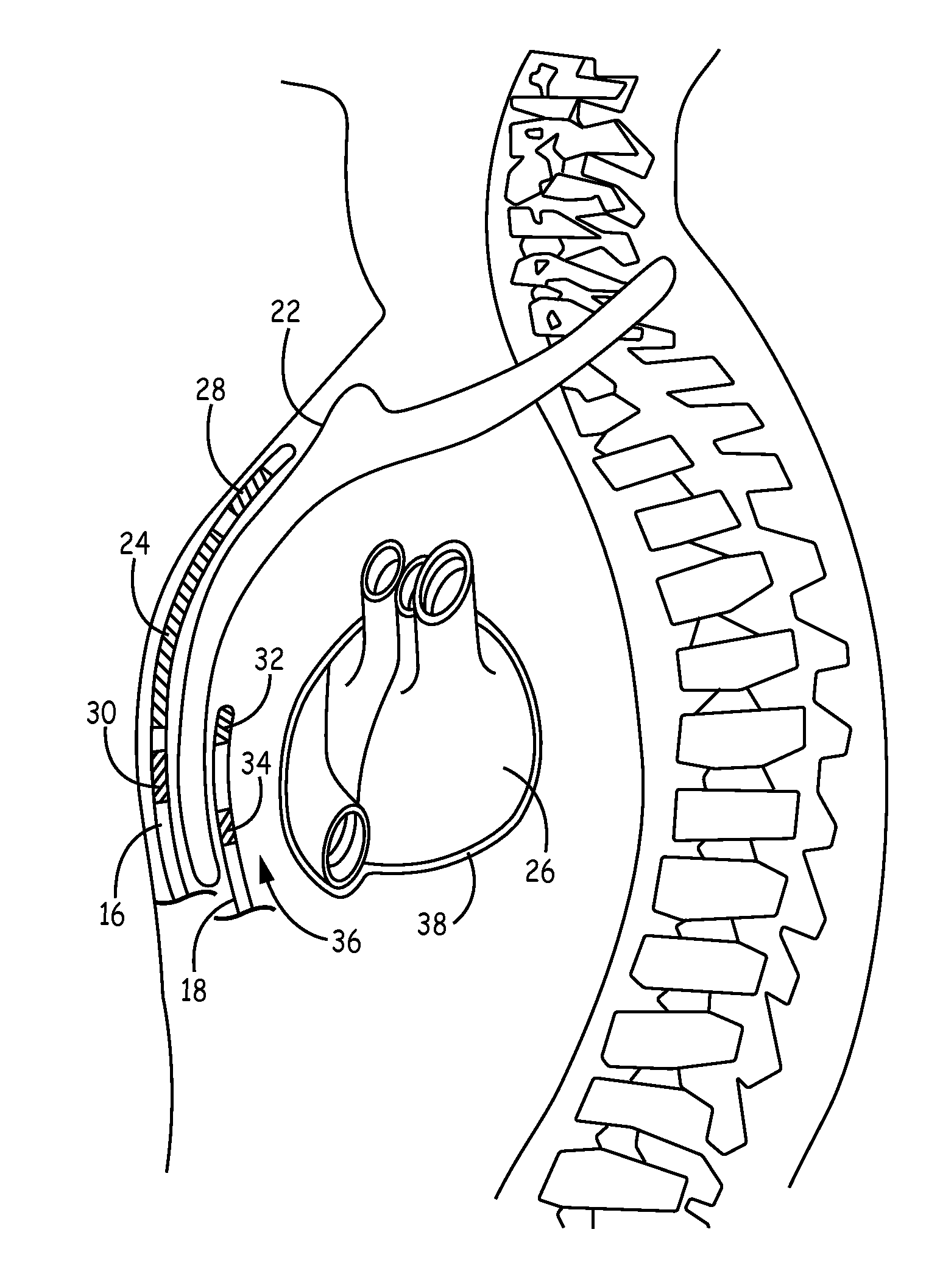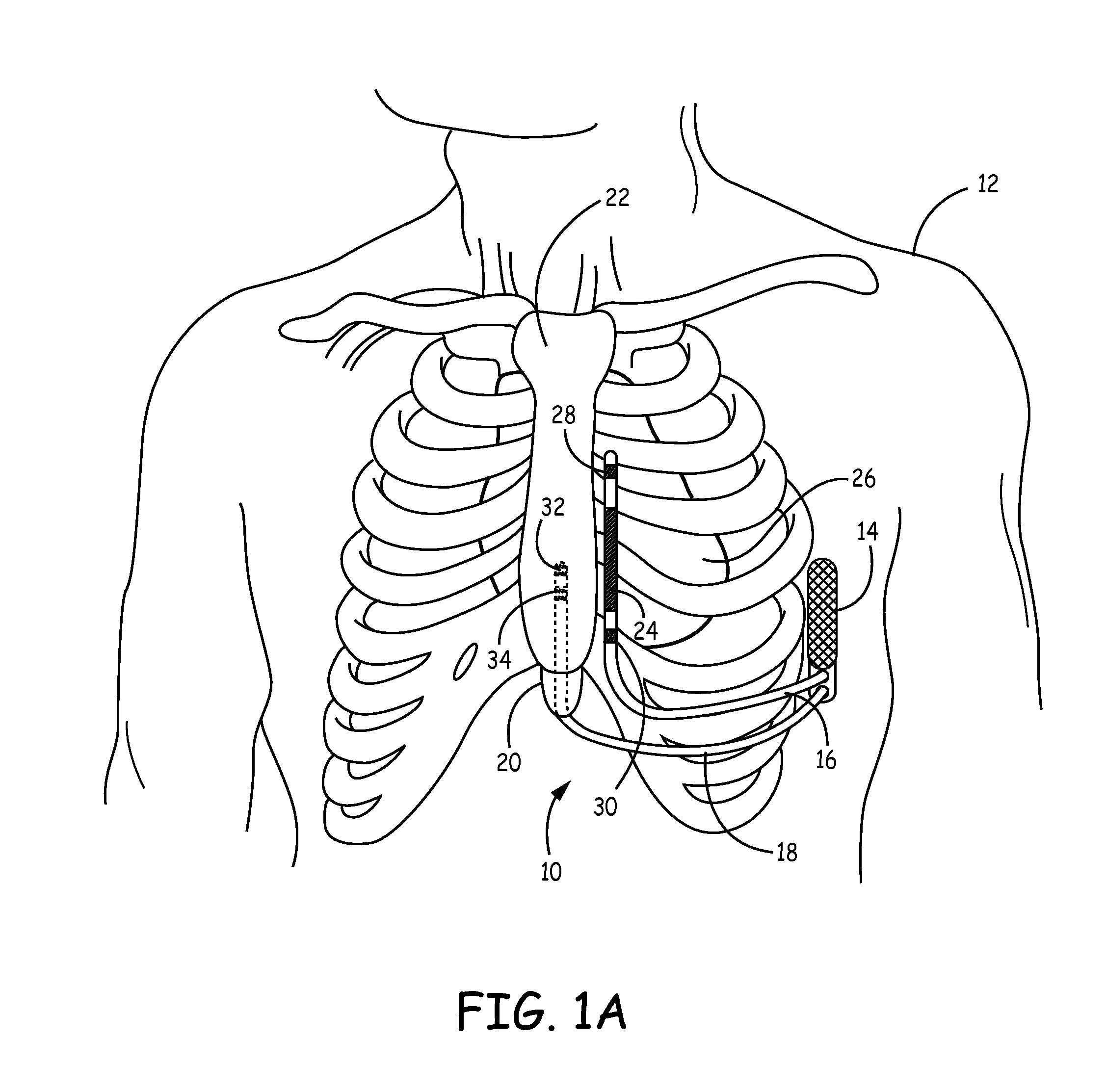Implantable cardioverter-defibrillator (ICD) system including substernal pacing lead
a cardioverter and defibrillator technology, applied in the direction of heart defibrillators, internal electrodes, therapy, etc., can solve the problems of subcutaneous icds requiring more storage capacitors, affecting the performance of subcutaneous icds, and affecting the effect of blood circulation,
- Summary
- Abstract
- Description
- Claims
- Application Information
AI Technical Summary
Benefits of technology
Problems solved by technology
Method used
Image
Examples
experiment 1
[0081]In the first acute study, a Medtronic Attain bipolar OTW 4194 lead was implanted substernally / retrosternally, and two active can emulators were positioned, one in the right dorsal lateral region (ACE1) and one on the right midaxillary (ACE2). The 4194 lead was placed directly below the sternum, in the mediastinum, with the lead tip and body running parallel to the length of the sternum. Various pacing configurations were tried and electrical data collected.
[0082]The smallest threshold observed was 0.8 volts, obtained when pacing from the tip of the substernal / retrosternal 4194 lead to ACE1 (10 ms pulse width and Frederick Heir instrument as the source of stimulation). It was possible to capture using a smaller pulse width, though threshold increased as the pulse width shortened (1.5V at 2 ms in this same configuration with a by isolater, made by FHC product #74-65-7, referred to herein as “Frederick Heir Stimulator.” Many additional low thresholds (1-2 volts) were obtained wit...
experiment 2
[0086]A second acute experiment was conducted. In the second acute, however, the animal presented with pericardial adhesions to the sternum. Because of the pericardial adhesion, the ventricular surface of the cardiac silhouette was rotated away from the sternum—an anatomical difference that may have resulted in higher thresholds throughout this experiment.
[0087]As in the previous acute experiment, a Model 4194 lead was placed under the sternum. An active can emulator was placed on the left midaxillary. The tip to ring section of the 4194 was positioned over the cardiac silhouette of the ventricle, as observed by fluoroscopy, and this position is notated “Position A” on the strength-duration graph illustrated in FIG. 5. The lead eventually migrated a very short distance closer to the xiphoid process during stimulation (still under the sternum) to reach “Position B,” and additional electrical measurements were obtained successfully from this position as well.
[0088]The smallest thresho...
experiment 3
[0090]A third and final acute experiment was conducted demonstrating the feasibility of substernal / retrosternal pacing. As in the previous two acute experiments, a 4194 lead was placed under the sternum. An active can emulator was placed on the left midaxillary. In this experiment, the substernal / retrosternal 4194 lead was intentionally positioned so that the lead tip was initially near the second rib, far above the cardiac silhouette of the ventricle. The lead tip was then pulled back (toward the xiphoid process) one rib space at a time, collecting electrical data at each position. As in previous experiments, low capture thresholds were obtained when the pacing electrodes were approximately positioned over the ventricular surface of the cardiac silhouette, as observed via fluoroscopy. When the lead tip was not over the ventricular surface of the cardiac silhouette, “no capture” was often the result.
[0091]As in previous experiments, pacing was performed from either the tip or the ri...
PUM
 Login to View More
Login to View More Abstract
Description
Claims
Application Information
 Login to View More
Login to View More - R&D
- Intellectual Property
- Life Sciences
- Materials
- Tech Scout
- Unparalleled Data Quality
- Higher Quality Content
- 60% Fewer Hallucinations
Browse by: Latest US Patents, China's latest patents, Technical Efficacy Thesaurus, Application Domain, Technology Topic, Popular Technical Reports.
© 2025 PatSnap. All rights reserved.Legal|Privacy policy|Modern Slavery Act Transparency Statement|Sitemap|About US| Contact US: help@patsnap.com



